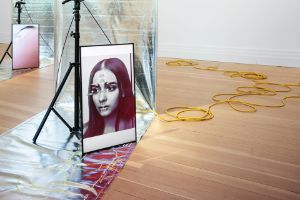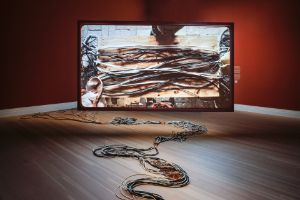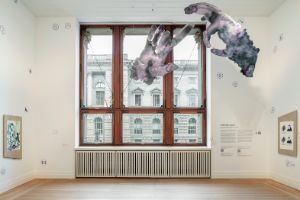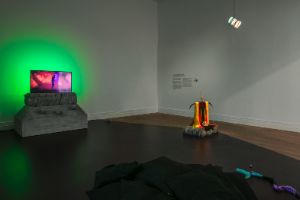Exhibition texts
Ether’s Bloom: A Programme on Artificial Intelligence
Introduction
Emerging developments in artificial intelligence (AI) are touching everyone and everything – excluding, connecting, and otherwise affecting human and non-human entities alike. In this moment of anticipation and criticism, the programme Ether’s Bloom invites us all to engage with the experimental, ethical, and poetic dimensions now blossoming through new networks of knowledge production.
The artists and thinkers in Ether’s Bloom challenge us to reconsider the established ways we relate to one another, to other life forms and to machines. From different perspectives, they use self-learning technologies as a tool or topic to expose overlooked narratives and to open doors to spaces to be imagined anew. How can we think differently and responsibly about AI’s role in our entangled futures?
The multiple formats of Ether’s Bloom included artistic presentations, a new Writer in Residence format with K Allado-McDowell, the podcast Beyond and Within: AI Talks, as well as conversations and workshops.
A core component was the development of an app drawing from the ideas and criticality of the programme. Launching in spring 2024, this app makes new technologies available and serves as a tool for accessibility.
Elisa Giardina Papa

Ether’s Bloom: A Programme on Artificial Intelligence, Elisa Giardina Papa, installation view, Gropius Bau (2023)
photo: Luca Girardini
Shown for the first time together in the context of Ether’s Bloom, Elisa Giardina Papa’s trilogy of video works surveys the ways in which Al and digital economies are reframing the politics of labour and the practice of care.
Technologies of Care
By collecting stories of freelancers who provide care labour online, the video installation Technologies of Care (2016) investigates the complex relationship between labour, gender and the ethical challenges often faced by online workers. Using anonymising digital imagery, the video provides a glimpse into the lives of the workers who sustain the informal economy of on-demand care.
Cleaning Emotional Data
Cleaning Emotional Data (2020) furthers this research by focusing on emergent forms of Al micro-labor. For this video installation, Giardina Papa worked remotely for several companies “cleaning” data which were later used to train emotion recognition algorithms. Among the tasks she performed were the categorization of human emotions, the labelling of facial expressions and the recording of her own image to animate three-dimensional avatars. The video installation documents her labour while simultaneously questioning the biases ingrained in both historical and present-day technologies deployed in the categorisation of human expressions.
What remains radically incomputable? — Elisa Giardina Papa

Elisa Giardina Papa, Labor of Sleep, Have you been able to change your habits??, 2017
Courtesy: the artist and Galerie Tanja Wagner, Berlin; commissioned by the Whitney Museum of American Art
Labor of Sleep, Have you been able to change your habits??
Giardina Papa’s Labor of Sleep, Have you been able to change your habits?? (2017) is a series of sixteen short video fragments that whimsically reference self-improvement tutorials. The internet-based artwork addresses how fitness, wellness, and sleeping apps are increasingly proposed as remedies for crises in the public health care system. These video clips are viewable online and take over Gropius Bau’s website during sunrise and sunset.
What must we bury now so those who come after may harvest? — Mimi Ọnụọha
Mimi Ọnụọha
Mimi Ọnụọha’s art frames technology as a site that embodies cultural logics of knowledge and difference, as shaped by historical and colonial encounters. Her work points to the contradictions inherent in the premise of technological “progress” and illuminates a path for a more expansive understanding of technology that embraces the traditions and values of those whose histories have been erased in the name of development.
These Networks in Our Skin
These Networks in Our Skin (2021) is a short film showing people reclaiming their own traditional narratives using the cables and devices of the internet. Driven by evocative imagery and sounds, the film is inspired by lgbo cosmology. In some lgbo traditions, Ala, the goddess of the land and everything below it, intervenes in human activities, and is supplicated by works of art and gifts. The women in Ọnụọha’s film loosely adapt lgbo and other cosmologies to the digital infrastructure that surrounds us. By rewiring and reweaving the material realities of the Internet to re flect their own presences, they reconfigure it to embrace their own cultural beliefs and values.
The Cloth in the Cable
In the installation The Cloth in the Cable (2022), Ọnụọha embeds cables with spices, cloth, dust, yellow madras curry pepper, smoked paprika, ground calabash nutmeg and other materials, rewired with new meanings and ontologies. The work extends the Internet’s history and symbolises its presence and power over spaces and stories. For the Berlin version of this installation, Ọnụọha invited Berlin-based writer, poet and community organiser hn. lyonga - the Gropius Bau’s Neighbour in Residence 2023 – to embellish the work with a local and site –specific addition of broom fibers.
Ọnụọha focuses on the absences created by computational and data infrastructure - on what is left out rather than typically seen. Yet, her work corrects what she has called “algorithmic violence” - or the exclusive and repressive tendencies within technology - by creating new spaces of care, inclusion and connectivity.

Ether’s Bloom: A Programme on Artificial Intelligence, Mimi Ọnụọha, installation view, Gropius Bau (2023)
photo: Luca Girardini
What if AI could decode nature’s conversations for us? — kennedy+swan
kennedy+swan

Ether’s Bloom: A Programme on Artificial Intelligence, kennedy+swan, installation view, Gropius Bau (2023))
photo: Luca Girardini
In their artistic work, kennedy+swan propose a vision of the world in which human dominance is abandoned in favour of a harmonious coexistence with plants and animals, trusting their intelligence as much as we trust our own. In their videos, augmented and virtual reality experiences and 3D scans of handmade models, the artist duo illuminates the benefits of interspecies connections and reveals the constructive power of future AI systems.
The new commissioned work Mixed Signals (2023) delves into the intriguing relationship between Artificial Intelligence, non-human communication systems and our human perceptions of them. While AI is often seen as a symbol of our alienation from nature, this series of watercolours and AR works reveal unexpected ways to think about different forms of intelligence in flora and fauna and how to engage with them.
From robotic bees infiltrating real hives to the use of AI to identify biodiversity in forests, the series culminates with a meditating cow reaching enlightenment, challenging dominant views on animal cognition. kennedy+swan portray nature as a self-propagating neural system – albeit one that may exist partly beyond the access of human perception.
Each watercolour can be scanned using a mobile app, revealing an augmented reality scene, expanding the narrative of the paintings. As well as an engaging and playful visualisation of non-human intelligence, the project is partly the result of AI itself, as ChatGPT acted as a sparring partner in the coding of the Mixed Signals app.
How can we decodify the organic planetary intelligence we hold inside? — Patricia Domínguez
Patricia Domínguez
Patricia Domínguez’s works explore ecological myth-making, multispecies relationships and digitisation of life under corporatied, late capitalism. Through sculpture, video, publications and educational projects inspired by her research on ethnobotany and healing practices, Domínguez views art as a tool for decolonial emancipation to transcend and resist today’s neoliberal condition.
The works explore various dimensions of spiritual and non-human intelligences. Derived from research from residency at CERN, the European Organization for Nuclear Research, and from exchange and learning with Chilean healers, the video Holographic Milk (2021) takes viewers on an inner discovery through spirituality, ecological prophecies and quantum physics. Structured as a meditative prayer and supplication, the video engages with organic matter as its own information system.
Madre Drone (2019-2020) originates from the artist's first-hand accounts of experiences in the region of Chiquitania in Bolivia: the rise of Amazon fires and the protests that took place a month later in adjacent Chile left behind devastated habitats and animals, while protesters were made blind through police violence. The work serves as an invocation of a new way of being that merges technology and planetary memory. Depicting a realm of plants and natural beings involving a womanserpent, a blind toucan, psychedelic cacti and anti-drone laser lights, Madre Drone ultimately summons us to witness a shamanistic experience amid visionary, interwoven worlds. It is an invitation to think about our relationship with machines and plants and what we can learn with regard to Artificial Intelligence.

Ether’s Bloom: A Programme on Artificial Intelligence, Patricia Domínguez, installation view, Gropius Bau (2023)
photo: Luca Girardini